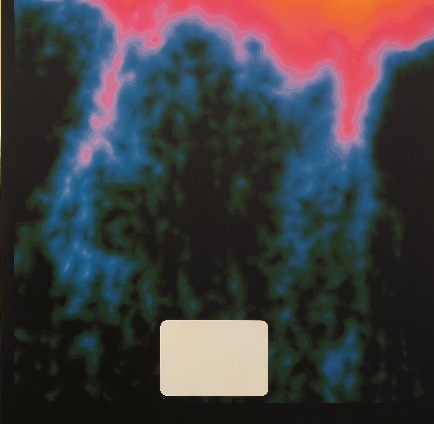
Jack Goldstein
Canadian, 1945-2003 (active USA)
Untitled, 1989
acrylic on canvas
72 x 72 x 6 in.
SBMA, Museum purchase with funds provided by the Mr. and Mrs. Ernest A. Bryant III Acquisition Endowment Fund
2008.56
"I am interested in the gap between Minimalism and Pop Art: in the object character and autonomy of Minimalism and the subject matter of our culture that is to be encountered in Pop Art." - Jack Goldstein
COMMENTS
In the 1980s, Jack Goldstein’s Photorealist paintings of lightning storms and other luminous phenomena made an indelible impression. Copied from found photographs and impeccably airbrushed by assistants, Goldstein’s images of spectacular, ephemeral events (usually against night skies) form the center of this compact yet fascinating survey. These untitled paintings — such as one dated 1983, featuring a stark horizon under green clouds being struck by knots of forked lightning at opposite ends of the canvas — were among the most provocatively beautiful of their time, a period when beauty itself was suspect as a tool of patriarchal repression. But, untouched by the artist’s hand, they seemed equally challenging as illustrations of the “death of the author,” philosopher Roland Barthes’s influential idea that literary texts were cultural constructs rather than transparent instantiations of a writer’s intention and biography.
As this may suggest, Goldstein was a charter member of the “Pictures Generation,” a group of artists interested in appropriating images from popular culture for deconstructive purposes. Like several of them, he studied at CalArts under John Baldessari. He made forays into Minimalist sculpture and performance art, but a series of short films from the mid-1970s led to his inclusion in curator Douglas Crimp’s defining Artists Space exhibition, “Pictures,” in 1977.
His canvases, however, never achieved the critical traction of his films, not even when they appropriated familiar icons, like a 1981 composition that faithfully reproduces Margaret Bourke-White’s WWII photo of the bombing of Moscow, the starry sky lit up by flares and rocket trails. In the end, the work was still painting, which starchy academics had declared dead, a moribund zombie that refused to lie down. These days, Goldstein’s flawless rendering of fleeting moments captured by photography — often blown up to a cinematic scale — seems entirely up-to-date, a genre-bending essay on how representation operates, and why paintings still possess a compelling magic different from that of other kinds of images. Think of the work of Richard Phillips, say, or Marilyn Minter.
Goldstein’s paintings from the late 1980s abandoned photographic sources in favor of computer-generated thermal imaging, looking like intensely hued topographic maps. Despite their seductively baleful glow, critics at the time misinterpreted them as Neo-Geo abstractions. Now they appear prescient, predicting our culture of surveillance, Google Earth and digital scans.
- Joseph R Wolin, TimeOut, August 12, 2013
http://www.timeout.com/newyork/art/jack-goldstein-x-10-000
SBMA CURATORIAL LABELS
Goldstein, whose career encompassed film, performance, sound, writing, and painting, is associated with artists of the Pictures Generation. They came of age in the early 1970s and produced works rooted in appropriation and media theory. Goldstein’s paintings drew inspiration from found images of World War II, space missions, and astronomical phenomena. Made mostly by assistants, his paintings are devoid of any hint of the artist’s hand. “Untitled” is from a series referred to as “heat sensor paintings,” wherein gradations of color are achieved by applying multiple tiered layers of solid color. As such, these works can be read as a digital image or a topographical map. His heat sensor paintings are harbingers of the digital era.
- In the Meanwhile Part II, 2021
Jack Goldstein’s expansive oeuvre is comprised of performance, film, recording, painting, visually-presented aphorisms, and texts. One of the most noted “artists’ artists” of his time, in the 1980s Goldstein became interested in creating paintings inspired by digital artifacts that showed no trace of the human hand. Untitled (1989) is an example of this process, which combines stenciling, color mixing, and the use of airbrush. His interest in the digital was, according to his apprentice Lorne Lanning, rooted in Goldstein’s belief “that our society was living in a matrix-like illusion, and that it was being fabricated by a powerful shadowy elite…providing most of our stimulus input through media.” While the imagery of his paintings may now appear familiar — comparisons include those related to heat sensors or night vision goggles — it now recalls reportorial warfare images published much later, including those of the Gulf War.
- Left Coast: Recent Acquisitions of Contemporary Art, 2014
